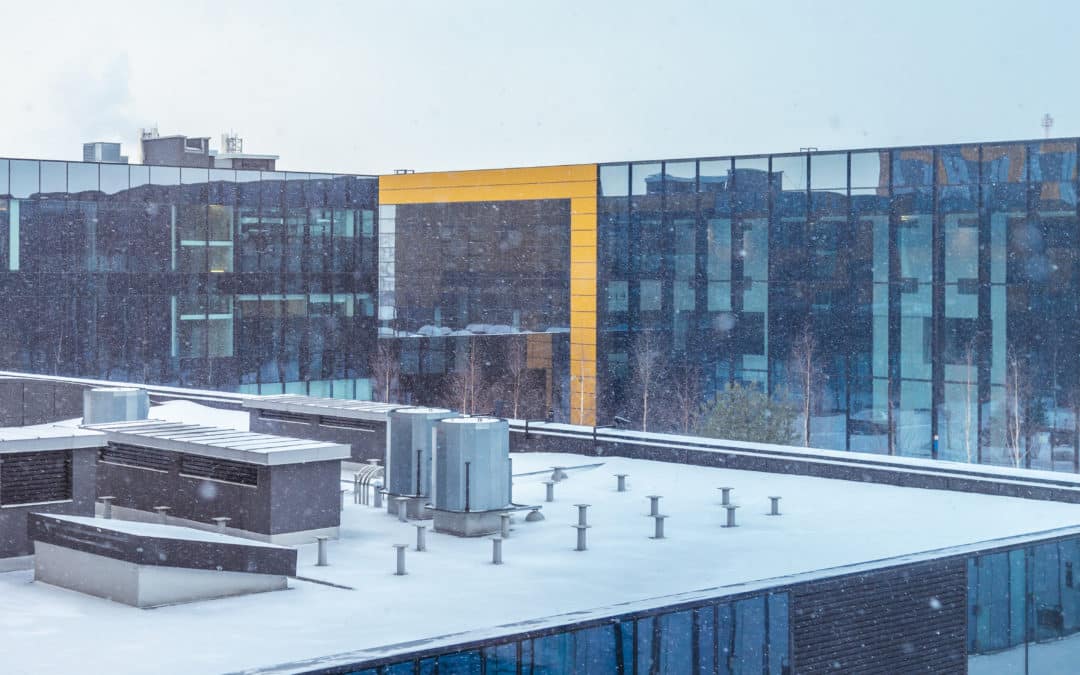Your commercial roof is your business building’s first line of defense against the elements. If you live in a region that experiences severe or even mild winters, you should consider implementing a winter commercial roofing maintenance plan.
The extreme conditions during winter can cause a significant amount of damage to your building’s roofing and construction, especially if your roof hasn’t been properly maintained and protected.
A winter planning maintenance program can help identify possible issues that may become problematic because of thermal motion during the summer and problems associated with snow and ice collecting on the roof during the winter. Ideally, you should schedule an appointment to fix any roof problems before the snow and rains of winter come. It is much easier (and safer) to make repairs and install preventative maintenance when the roof is dry. Routine upkeep and executing a winter-prep program reduces the danger of harm to your commercial roof and reduces damage due to water entering the building through a leak in the roof.
Roof Inspections
Since commercial roofs are continuously exposed to the outside elements, a professional business roofing contractor must perform regular inspections. The summer heat may cause fractures in the membrane, while hefty winds can lead to uplift. This damage often goes unnoticed until winter, when the roof can sustain even additional harm from heavy snow loads or ice growth.
To decrease the probability of flows — or worse, a complete roof segment collapsing — it is vital to recognize and remove all flaws and issues of your building’s roof before winter starts. Our specialists recommend conducting at least two roof inspections each year, one in the fall to prepare for winter and one in the spring to locate and fix any harm the winter weather may have caused.
Every portion of your industrial roofing system ought to be scrutinized: the decking, insulation, any underlayment, the outer membrane, all roofing vents, drainage gutters, and pipes. A failure at any part of your roof could lead to troublesome damage. Membrane failures, like broken seams, cracks, holes, buckles, and blisters, are the most frequent problems, but out-of-place attachments, clogged drainage systems, and rooftop debris may also hurt roofs throughout the chilly season.
Roof Cleaning
Often many business building owners get their winter roof inspection in the fall. During this inspection, make sure to clean up leaves and debris that are covering the roof surfaces. We also ensure all loose components are taken off or strapped down, to prevent them from blowing about in high winds.
When leaves and debris accumulate in your commercial building’s gutter, it can result in a clog at the downspout. This can cause the rainwater to float in the gutters, potentially damaging the roof and outside of the building.
You should ensure that the gutters are comparatively clear to protect against these issues and unanticipated repair costs. When the trees near your building are devoid of leaves, it is an optimum time to perform a comprehensive roof cleaning.
Snow and Ice Removal Plan
If your building is in a region where ice and snow are common, it is a fantastic idea to select a roof ice and snow removal program. If snow is not immediately removed from the roof, the snow could melt through the day and re-freeze. Throughout the freeze/thaw cycle, the ice tends to mold around roof drains and limit appropriate drainage. This becomes a critical hazard due to the extra weight it puts on the roof. Also, as the ice and snowmelt, water may seep into cracks and crevices in the roofing system and freeze, enlarging any openings and resulting in extra damage and expensive repairs.
Preventive Care
The perfect approach to prevent roof-related troubles and fortify weather resistance is routine maintenance and preventative care programs. Appropriate maintenance prolongs the roofing’s life span and, in many cases, allows for repair rather than replacement if an issue is identified. To ensure major problems don’t get overlooked, we recommend scheduling an inspection at least every six months.
With preventative and regular maintenance combined with a winter inspection program, you can prolong the longevity of your business’s roofing and protect it against acute damage. Give us a call to ask about our roof maintenance program and to get a free quote! When you choose our inspection service, you can have peace of mind when winter weather arrives.

